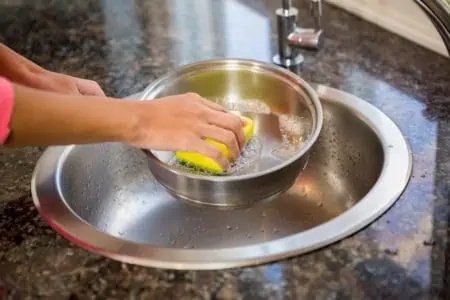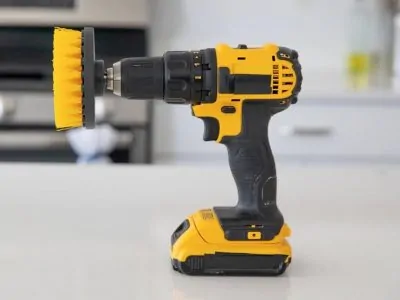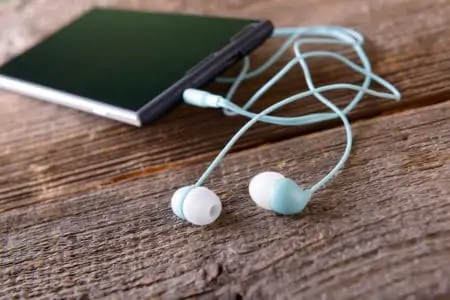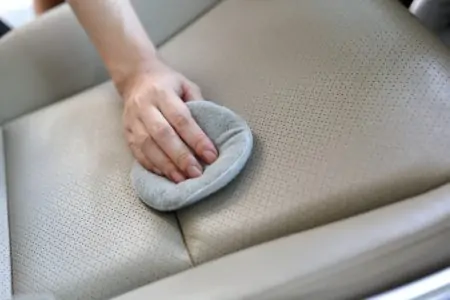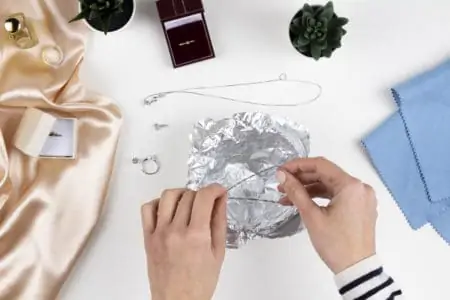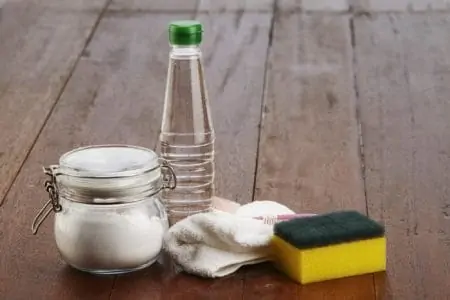You likely have plenty of aluminum items in your house. This could include pots and pans, tables, cleaning tools, boats, picture frames, and much more. These items can become dirty and dull, so you need to clean them properly.
You want to make sure that you don’t scratch or discolor the aluminum. We’ll show you how to clean aluminum without causing damage. This step-by-step guide will walk you through cleaning aluminum cookware, window frames, wheels, and more.
Keep reading to learn everything there is about caring for aluminum.
Key Takeaways
- Clean aluminum with everyday products like vinegar, Borax, detergent, lemon juice, or baking soda.
- To prevent scratches, use soft sponges, pads, or microfiber cloths for cleaning.
- Aluminum oxidation can be removed using a 1:1 vinegar and water solution.
- Proper care for aluminum items includes avoiding harsh cleaning methods and drying them thoroughly.
Home Remedies for Cleaning Aluminum
Some of the best methods for cleaning aluminum utilize the power of everyday products that you probably already have at home. We’ll walk through five great, ordinary cleaners you can use to get your aluminum sparkling again.
Vinegar
Distilled white vinegar is an acidic non-toxic cleaner. It can kill bacteria, cut through grease and grime, and eliminate hard water deposits. It’s an incredibly versatile cleaner that we use all around our home. Plus, it’s a fraction of the price of other household cleaners.
If you aren’t a fan of the smell, you can always add 10 drops of essential oil to the mix.
When using vinegar for cleaning aluminum, make sure you dilute it in a 1:1 ratio with water.
Borax
Borax is a product that contains sodium tetraborate, which is a natural mineral that’s been used in cleaning products for years. Borax can remove mold, mildew, and general stains. For use on aluminum, you can make an all-purpose spray by combining two teaspoons of Borax with four cups of hot water.
For stains, you can mix ¼ cup of Borax with a few drops of water to create a paste which you can apply directly to the aluminum.
Detergent
Dish detergent is an easy way to clean aluminum. Mix two cups of water with two tablespoons of dish soap to create a cleaner. Put it in a spray bottle for easy application. Always rinse after using dish soap to avoid leaving any streaky residue behind.
Lemon Juice
Have some spare lemons you don’t know what to do with? Clean aluminum with them! Since lemons are high in citric acid and have natural antibacterial properties, they’re great for cleaning various surfaces. Plus, they smell amazing.
Simply cut a lemon in half and scrub the aluminum until it sparkles. If you want to add some salt to the lemon surface, this will help cut through grease and grime.
Baking Soda
Baking soda is another non-toxic, gentle, abrasive cleaner that can kick dirt, grease, and grime to the curb. Plus, it doesn’t leave scratches! It’s also a tremendous deodorizer.
To use it on aluminum, you can make a paste by mixing it with water at a 1:1 ratio and applying it directly to the aluminum.
Try This Combo
Did you know that you can clean with vinegar and baking soda? Make a 1:1 ratio of vinegar and water, then add a few tablespoons of baking soda for extra cleaning power.
How to Clean Aluminum Without Scratching
Scratches are what we fear most with aluminum. To avoid scuffs and scratches, make sure to avoid highly abrasive cleaners. The only exception should be baking soda or a little bit of salt with lemon juice.
When choosing your tools, always make sure that you are using soft sponges, pads, or cloths. Microfiber is our preferred option. Never use scratchy sponges or steel wool, as this can damage your aluminum surface.
How to Clean Aluminum
Let’s get into the ultimate guide for cleaning aluminum. We’ll walk through five common aluminum products so that you are clued up on cleaning almost every aluminum item in your home. Get ready for the best way to clean everything aluminum!
- Time: 30 minutes
- Difficulty: Easy
What You’ll Need
- Cleaner of choice (vinegar, borax, detergent, lemon juice, or baking soda)
- Water
- Spray bottle
- Bowl
- Spoon
- Sponge, pad or cloths
- Toothbrush (optional)
- Wooden spoon (optional)
- Garden hose or pressure washer (for cleaning wheels)
- Soft-bristled brush (for cleaning wheels)
- Towel (for cleaning wheels)
Cleaning Pots and Pans
First up, let’s clean that cookware. This method will focus on cleaning your aluminum cookware after each use but also on how to remove burnt bits of food.
- Let it cool: Wait for the cookware to cool down before washing. If you expose it to cool water while it’s still hot, the cookware can warp.
- Wash with soapy water: Fill a sink with warm soapy water. Submerge the cookware and gently scrub it with a soft sponge, pad, or cloth to remove as much dirt as possible.
- Rinse: Rinse well with warm water to remove any soapy residue.
- Remove stains: To remove stains, fill the pot or pan with water, leaving two inches at the top free so that the water can bubble. Add two tablespoons of your chosen cleaner. For this method, though, vinegar or lemon juice will work wonders.
- Boil: Bring the water to a boil and simmer for 15 minutes.
- Cool and empty: Let the contents cool. Then pour out the water.
- Scrub: Gently remove loosened residue using a soft sponge, pad, or cloth. It might also help to scrape it off with a wooden spoon.
- Rinse and dry: Rinse again with warm water and wipe it dry with a dish towel.
Cleaning Appliances or Sinks
How does one clean aluminum refrigerators, stoves, or sinks? Check this method out:
- Apply dish soap: Apply dish soap all around an empty sink or appliance. You can spread it around with your hands, but we recommend wearing gloves for this step. If you use your bare hands, you could dry your skin out or have irritation.
- Wipe: Dampen a cloth with warm water and scrub the sink or appliance clean to remove all grease and grime.
- Deep clean with lemon: Cut a lemon in half and sprinkle salt on the open side. Scrub the sink or appliance well with the lemon to brighten the aluminum and remove extra grime.
- Rinse: Dampen a cloth with water and rinse the sink or appliance well.
- Dry: Wipe the sink or appliance again with a separate dry cloth to remove water residue.
Top Tip
Cleaning the sink or appliance regularly with dish soap will keep it in good shape. You can always dilute dish soap in a spray bottle and use this as your appliance and sink cleaner.
Cleaning Window Frames
It’s important to clean your window frames regularly. For aluminum window frames, use this method:
- Make solution: Mix one cup of water per tablespoon of dish soap in a spray bottle. Increase the quantities as necessary.
- Spray frames: Spritz the detergent solution over the aluminum window frames.
- Wipe: With a microfiber cloth, wipe the solution away.
- Rinse: Use a separate damp cloth (just plain water) to rinse the frames.
- Dry: Use another separate dry cloth to dry the window frames.
Try Any Cleaner
While we recommend dish soap for this method, you can experiment with any of the recommended cleaners to find which one suits you best.
Cleaning Wheels
- Rinse: Use your garden hose or pressure washer to rinse the wheels well.
- Make solution: In a large bucket, mix your cleaner. You can use any of the recommended cleaners, or you could even mix a couple. For instance, mix vinegar and dish soap in a bucket of water. You can do some trial and error. You could also pour some of the cleaner into a spray bottle.
- Apply cleaner: Either spray the cleaner onto the wheel. Or you can dip a cloth or sponge into the bucket and scrub it straight onto the wheel. Continue until the aluminum is clean.
- Tackle tough spots: Some parts of the wheels might still be dirty. In a bowl, make a baking soda paste. Use a cloth or soft-bristled brush to apply it directly to the stained parts of the wheel. Scrub in well with a cloth or sponge.
- Rinse: Rinse the wheel again with your garden hose or pressure washer.
- Dry: Use a towel to dry the wheels.
Cleaning Utensils
Aluminum is popular for utensils, such as silverware — even antique, old, or intricate items. To clean these utensils, try this method:
- Wash in soapy water: First, fill a sink with warm water and dish soap. Wash the utensils normally, scrubbing gently with a cloth.
- Rinse and dry: Rinse and dry the utensils. If they’re still dirty and dull, move on to the next step.
- Make stain removal solution: Mix together your 1:1 solution of vinegar and water in a pot.
- Boil: Put the utensils in the solution and bring the pot to a boil for 10 minutes.
- Drain: Drain the water and leave the utensils on a towel to cool.
- Wash: Rewash the utensils in warm soapy water. Then rinse and dry.
- Shine: If the utensils are still dull, you can shine them up with the baking soda or lemon trick. Afterward, rinse and dry them again.
How to Clean Aluminum Oxidation
If your aluminum looks like it has corrosion, or is covered in white and black marks and streaks, this is a chemical process called oxidation. This process happens when the aluminum comes in contact with oxygen or an oxidizing agent. It creates a thin, hard film known as oxidation. Don’t panic, though. This is natural and reasonably straightforward to remove.
- Time: 25 minutes
- Difficulty: Easy
What You’ll Need
- Vinegar
- Water
- Pot
- Two cloths
- Soft-bristled brush
1. Prepare Vinegar
Combine a 1:1 ratio of distilled white vinegar and water in a large pot.
2. Boil Vinegar
If you’re cleaning a small aluminum item, place it in a pot of vinegar-water solution. Bring the pot to a boil and let it simmer for 15 minutes.
If you’re just cleaning an oxidized pot, this is a great method for cleaning the pot.
If you’re cleaning a larger area, like a sink or table, we’ll tackle that later.
3. Clean Larger Items
For large items, soak a cloth in the boiled vinegar-water solution. Wring it out a little, but leave it damp enough to saturate the large surface. Scrub the stubborn areas with a soft-bristled brush. Wipe again with vinegar to remove loosened oxidation.
4. Rinse
No matter what you clean, whether it is a pot, large sink, or small spoon, rinse it well with water. Use a running tap or a dampened cloth. Dry it off well with a dry cloth.
How to Polish Aluminum
For aluminum that doesn’t want to shine using any of our home remedies, you can use a commercial metal polish. We suggest, Mothers Mag & Aluminum Polish as this is a popular choice. No matter what product you choose though, read the instructions on the packaging for application advice. This usually involves applying it directly to the aluminum using a soft cloth.
Tips For Caring For Aluminum
Let’s share some additional maintenance tips before we go so that you can ensure that you’re treating your aluminum right.
- Only soft utensils while cooking: When cooking with aluminum cookware, avoid hard utensils such as other metal utensils or steel wool. Instead, stick to plastic, silicone, or wooden utensils. This will prevent scratching and chipping of your cookware.
- Be careful with acidic foods: Whether you used your cookware to cook acidic foods, you spilled some on your aluminum table, or you ate acidic foods with an aluminum fork and knife, always clean the aluminum items as soon as possible. Never use aluminum cookware to store food. It can wear the aluminum down over time.
- Avoid drastic temperature changes: Don’t subject aluminum to super high heat. When it does get hot, make sure you give it time to cool down before cleaning, as the temperature change can warp the aluminum.
- Avoid the dishwasher: Don’t put aluminum cookware or utensils in the dishwasher. The harsh detergent can scratch your cookware.
- Always dry aluminum: Leaving water on your cookware can cause water stains and mineral buildup.
